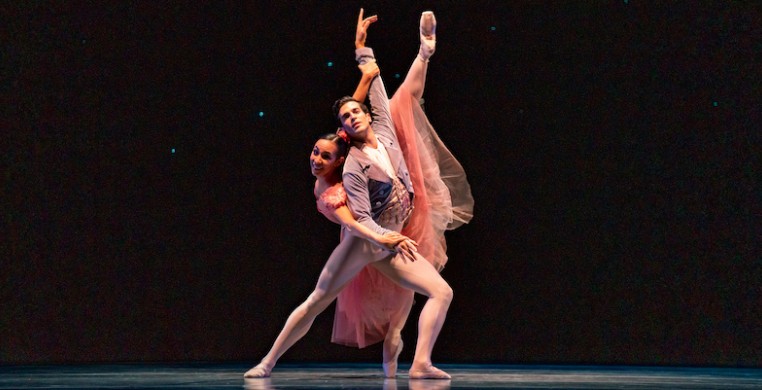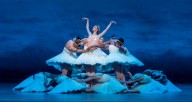“Welcome to our new home,” said Joffrey Ballet artistic director Ashley Wheater in a brief pre-performance curtain speech on Wednesday evening at the Lyric Opera House. After 20 years calling the Auditorium Theatre home and 18 months mired in a pandemic that canceled live, in-person shows, Chicago’s premier ballet company took the stage launching a new season, at a new home with a renewed sense of hope and a lot of emotion and enthusiasm. Home has many definitions; the most common is a place where one lives. It also can be a place where something flourishes. The latter is the case with Joffrey’s season opener, “Home: A Celebration.”
Three of the works on the mixed-bill program were created during the pandemic and premiered as part of an online video series earlier this year. Each showcased choreographers at different stages in their careers and were filmed in Joffrey’s black box theater, an intimate setting that made viewers feel extremely close to the dancers. Moving those pieces to the vast Lyric stage and keeping that sense of proximity was a challenge that worked with varying degrees of success. Each of these works, while beautifully danced, held a feeling of melancholy reflecting the time and circumstances of when they were created. The outlier, a piece created by Joffrey co-founder Gerald Arpino, was a bright, welcome nod to the company’s history.
The curtain opens on “Birthday Variations” to a sparkling black backdrop adorned with twinkling, embedded chandeliers and one giant chandelier hanging center stage – an impressive first image. Dancers crisscross the stage, then meet in the middle to form a tableau with a man in the middle surrounded by five women. They break out into patterns with solos, a pas de deux, a finale. The classic structure, pure technique and pastel costumes harken to a bygone era. And in a sense, it was. “Birthday Variations” was choreographed in 1986 and had its premiere on the Lyric stage. To see this new generation of dancers tackle the pristine choreography was fascinating, especially considering none of them were even born when Arpino created it.
Dancers have evolved physically and mentally in the decades since and it clearly showed: think old school choreography upgraded with new technology. Amanda Assucena, as the lead female, delighted in the opportunity to use her many natural gifts to play with and in the steps, her eyes and smile matching the twinkling lights behind her. The genuine affection and trust she has with her partner Alberto Velazquez reflected in every minute they were together. Each soloist (Valeria Chaykina, Lucia Connolly, Gayeon Jung and Yumi Kanazawa) dazzled with their pirouettes and pointe work. Some may see “Birthday Variations” as dated but as it turns out, it was the perfect opener.
In “Swing Low,” 2020 Winning Works award-winner Chanel DaSilva navigates the worlds of humans and angels with her visceral choreography. The curtain rises on a single figure lying on the ground with white feathers floating down from above— another stunning tableau. A winged angel appears from the darkness to hold the anguished person. More angels appear and take turns lifting, caressing, guarding and comforting, perhaps representing the archangels. All five dancers in the piece are in top form, easily navigating the more contemporary choreography with finesse. Shout out to Ellie Cotey and the wardrobe department for the stunning angel wings which moved as gracefully as the dancers. In a star turn as the human figure who eventually ascends with the angels, Fernando Duarte proved you can hold an audience rapt with acting skills paired with talent, heart and soul (reminiscent of a 2019 solo role Duarte danced in a ballet also called “Home”).
Joffrey ballet master Nicolas Blanc’s “Under The Trees’ Voices” is his strongest choreographic offering to date, pulling from his previous successes and adding new layers. He especially thrives in the pas de deux incorporating effortless and inventive lifts and complex partnering. The three main couples (Assucena and Velazquez, Jung and Temur Suluashvili, and Jeraldine Mendoza and Dylan Gutierrez) are stand outs in this piece for 15 dancers. In adapting it for the Lyric stage, the work lost some of the immediacy created from the original staging for film, but with Blanc’s curiosity and creativity, “Trees” will continue to evolve and take root in Joffrey’s repertoire.
In the final piece in the program, company artist Yoshihisa Arai takes on Ravel’s famous score “Bolero.” The lead dancer, a gorgeous Anais Bueno, stays on stage for the entirety of the piece becoming more and more agitated, personifying the escalating drone of the music. Program notes offer a glimpse into the work stating the main figure is a “muse…leading ‘disciples’ through a serene world of light and shadows.” Does that come across to the audience? Not necessarily. Is that OK? Yes. Arai shows promise with his instincts and talent in creating on the male dancers who do the bulk of the dancing. Suluashvili, another company artist, takes on the role of costume designer with Bueno clad in an oversized, white men’s shirt and the men and women in the corps dressed similarly in floor-length skirts and wrap pants. Kudos to Wheater for giving his dancers the opportunity to learn and grow and explore their crafts in a safe space.
For the Joffrey, home is Chicago. Home is the theater. Home is the stage. Home is dance.
Welcome home.
--
The Joffrey Ballet's "Home: A Celebration" continues through Oct. 24 at the Lyric Opera House, 20 N. Wacker Drive. Tickets are $35-$169 and available by clicking the event page below.


